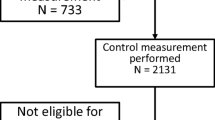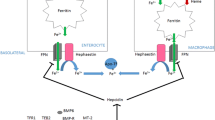Abstract
Hereditary hemochromatosis (HHC) is a genetic disorder of iron metabolism characterized by abnormal accumulation of iron that may lead to organ damage and death. Diagnosis is usually based on various genetic and phenotypic criteria. The study goals were to perform mutation analysis for 18 different mutations associated with HHC in healthy Lebanese, determine their allele frequency, and compare iron-overload status in identified carriers versus those found to be wild-type for mutations analyzed. 116 healthy adults (59 males and 57 females) underwent DNA testing for 18 different HHC mutations, and biochemical testing for percent transferrin saturation (%TS) and ferritin. C282Y mutation was not detected. Only H63D mutation (rs1799945) was found with an overall carrier frequency of 25.8% (24.1% heterozygous and 1.7% homozygous). %TS and ferritin differed significantly between genders. %TS and ferritin were significantly higher in males with H63D mutation when compared to males with wild-type (P = 0.001, 0.019; respectively); but not in females. The proportion of subjects with increased %TS and serum ferritin was not statistically different between those with H63D mutation and the wild-type in either gender. In addition, none of the subjects had concurrent increase in %TS and ferritin. In conclusion, the H63D carrier frequency in healthy Lebanese is comparable to other populations in the region, and it does not result in significant biochemical iron overload. Moreover, in the absence of the C282Y mutation, genetic screening for HHC is not recommended according to this preliminary study in healthy Lebanese.

Similar content being viewed by others
References
Harmatz P, Butensky E, Quirolo K et al (2000) Severity of iron overload in patients with sickle cell disease receiving chronic red blood cell transfusion therapy. Blood 96:76–79
Edison ES, Bajel A, Chandy M (2008) Iron homeostasis: new players, newer insights. Eur J Haematol 81:411–424
Griffiths WJ (2007) The genetic basis of hemochromatosis. Aliment Pharmacol Ther 26:331–342
Hemochromatosis (2008) Online Mendelian Inheritance in Man, OMIM. Baltimore: McKusick-Nathans Institute for Genetic Medicine, August, 2008. http://www.ncbi.nlm.nih.gov/omim/
Lyon E, Frank EL (2001) Hereditary hemochromatosis since discovery of the HFE gene. Clin Chem 47:1147–1156
Brandhagen DJ, Fairbanks VF, Baldus W (2002) Recognition and management of hereditary hemochromatosis. Am Fam Physician 65:853–860
Pietrangelo A (2004) Hereditary hemochromatosis—a new look at an old disease. N Engl J Med 350:2383–2397
McLaren CE, Li Kt, McLaren GD et al (2006) Mixture models of serum iron measures in population screening for hemochromatosis and iron overlaod. Transl Res 148:196–206
Adams PC, Reboussin DM, Press RD et al (2007) Biological variability of transferrin saturation and unsaturated iron binding capacity. Am J Med 120:997–999
Whitlock EP, Garlitz BA, Harris EL et al (2006) Screening for hereditary hemochromatosis: a systemic review for the U.S. preventive services task force. Ann Intern Med 145:209–223
Feder JN, Gnirke A, Thomas W et al (1996) A novel MHC class I-like gene is mutated in patients with hereditary haemochromatosis. Nat Genet 13:399–408
Gurrin LC, Bertalli NA, Dalton GW et al (2009) HFE C282Y/H63D compound heterozygotes are at low risk of hemochromatosis-related morbidity. Hepatology 50:94–101
Gochee PA, Powell LW, Cullen DJ et al (2002) A population-based study of the biochemical and clinical expression of the H63D hemochromatosis mutation. Gastroenterology 122:646–665
Gurrin LC, Osborne NJ, Constantine CC et al (2008) The natural history of serum iron indices for HFE C282Y homozygosity associated with hereditary hemochromatosis. Gastroenterology 135:1945–1952
Alexander J, Kowdley KV (2009) HFE-associated hereditary hemochromatosis. Genet Med 11:307–313
Allen KJ, Gurrin LC, Constantine CC et al (2008) Iron-overload-related disease in HFE hereditary hemochromatosis. N Engl J Med 358:221–230
Hanson EH, Imperatore G, Burke W (2001) HFE gene and hereditary hemochromatosis: a HuGE review. Am J Epidemiol 154:193–206
Simsek H, Sumer H, Yilmaz E et al (2004) Frequency of HFE mutations among Turkish blood donors according to transferrin saturation: genotype screening for hereditary hemochromatosis among voluntary blood donors in Turkey. J Clin Gastroenterol 38:671–675
Alkhateeb A, Uzrail A, Bodoor K (2009) Frequency of the hemochromatosis gene (HFE) variants in A Jordanian Arab population and in diabetics from the same region. Dis Markers 27:17–22
Papazoglou D, Exiara T, Speletas M et al (2003) Prevalence of hemochromatosis gene (HFE) mutations in Greece. Acta Haematol 109:137–140
Yonal O, Hatirnaz O, Akyuz F et al (2007) Definition of C282Y mutation in a hereditary hemochromatosis family from Turkey. Turk J Gastroenterol 18:53–57
Bozkaya H, Bektas M, Metin O et al (2004) Screening for hemochromatosis in Turkey. Dig Dis Sci 49:444–449
Barut G, Balci H, Bozdayi M et al (2003) Screening for iron overload in the Turkish population. Dig Dis 21:279–285
Gunel-Ozcan A, Alyilmaz-Bekmez S, Guler EN et al (2006) HFE H63D mutation frequency shows an increase in Turkish women with breast cancer. BMC Cancer 6:37
Simsek H, Balaban YH, Yilmaz E et al (2005) Mutations of the HFE gene among Turkish hereditary hemochromatosis patients. Ann Hematol 84:646–649
Waalen J, Felitti VJ, Gelbart T (2008) Screening for hemochromatosis by measuring ferritin levels: a more effective approach. Blood 111:3373–3376
Allen KJ, Bertalli NA, Osborne NJ et al (2010) HFE Cys282Tyr homozygotes with serum ferritin concentrations below 1000 microg/l are at low risk of hemochromatosis. Hepatology 52:925–933
Neghina AM, Anghel A (2010) Hemochromatosis genotypes and risk of iron overload—a meta-analysis. Ann Epidemiol. doi:10.1016/j.2010.05.013 (ahead of print)
Acknowledgments
This study was supported by a fund from the Medical Practice Plan and from the Chairman’s fund of the Pathology and Laboratory Medicine Department at the American University of Beirut Medical Center. The authors are also grateful to Dr. Ghazi Zaatari, Department Chairman, for his continuous support.
Author information
Authors and Affiliations
Corresponding author
Rights and permissions
About this article
Cite this article
Mahfouz, R.A.R., Sarieddine, D.S., Charafeddine, K.M. et al. Should we screen for hereditary hemochromatosis in healthy Lebanese: a pilot study. Mol Biol Rep 39, 753–759 (2012). https://doi.org/10.1007/s11033-011-0795-1
Received:
Accepted:
Published:
Issue Date:
DOI: https://doi.org/10.1007/s11033-011-0795-1




